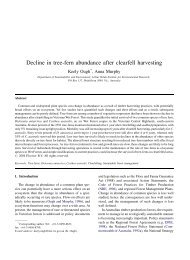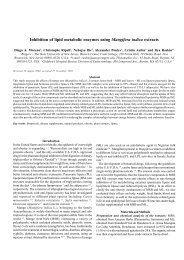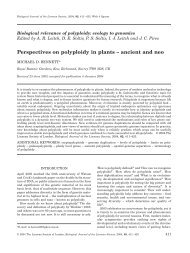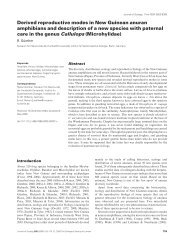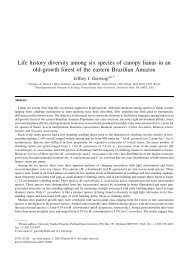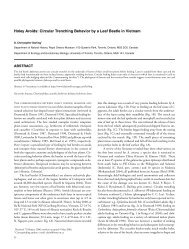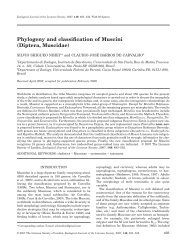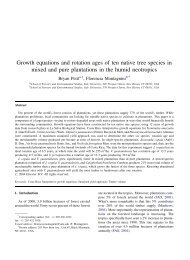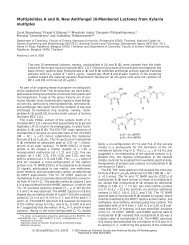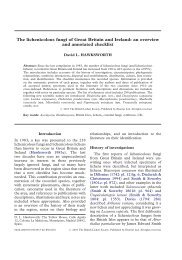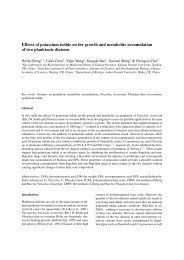Frequency of Cyanogenesis in Tropical Rainforests of Far North ...
Frequency of Cyanogenesis in Tropical Rainforests of Far North ...
Frequency of Cyanogenesis in Tropical Rainforests of Far North ...
You also want an ePaper? Increase the reach of your titles
YUMPU automatically turns print PDFs into web optimized ePapers that Google loves.
considered common (Gibbs, 1974; Hegnauer, 1990;<br />
Mabberley, 1990). In the Elaeocarpaceae family, cyanogenesis<br />
has previously been reported <strong>in</strong> only two species: the<br />
leaves <strong>of</strong> Vallea stipularis ‘pyrifolia’ F.Ballard (Gibbs<br />
1974), and the leaves [Gresh<strong>of</strong>f (1898) cited <strong>in</strong> Hegnauer<br />
(1973)] and the bark (Pammel, 1911; Rosenthaler, 1919) <strong>of</strong><br />
Sloanea sigun (Blume) K.Schum (syn. Ech<strong>in</strong>ocarpus<br />
sigun), were found to be cyanogenic. Sambunigr<strong>in</strong> was<br />
isolated from the leaves <strong>of</strong> S. sigun [R. Hegnauer and<br />
L. H. Fikenscher, unpubl. data (1983) cited <strong>in</strong> Hegnauer<br />
(1990)], the only previous report <strong>of</strong> a cyanogenic constituent<br />
<strong>in</strong> Elaeocarpaceae and Malvales. Characterization <strong>of</strong> the<br />
pr<strong>in</strong>cipal foliar cyanogenic glycoside—an apparently<br />
unusual phenylalan<strong>in</strong>e-derived glycoside with an organic<br />
acid residue—is ongo<strong>in</strong>g (Miller, 2004).<br />
Cleistanthus myrianthus (Hassk.) Kurz (Euphorbiaceae)<br />
This appears to be the first report <strong>of</strong> cyanogenesis <strong>in</strong><br />
the genus Cleistanthus, which consists <strong>of</strong> 100–140 species.<br />
Cleistanthus myrianthus is a subcanopy ra<strong>in</strong>forest tree (to<br />
7 m), found <strong>in</strong> the lowland and foothills from the Da<strong>in</strong>tree<br />
River to Rossville, north east Queensland (Cooper and<br />
Cooper, 1994). In Australia, it is classified as rare on the<br />
basis <strong>of</strong> this limited distribution, but it is also found <strong>in</strong><br />
Southeast Asia and Malesia (Hyland et al., 2003). <strong>Cyanogenesis</strong><br />
is especially common <strong>in</strong> Euphorbiaceae (300<br />
genera, 7500 species), and is found <strong>in</strong> many genera <strong>in</strong>clud<strong>in</strong>g<br />
Bridelia, Euphorbia and Phyllanthus, as well as the<br />
economically important species Hevea brasiliensis (rubber<br />
tree) and Manihot esculenta (cassava) (e.g. Rosenthaler,<br />
1919; Tjon Sie Fat, 1979a; Seigler et al., 1979; Adsersen<br />
et al., 1988).<br />
The chemotaxonomic utility <strong>of</strong> cyanogenesis, as well<br />
as other secondary metabolites (e.g. alkaloids and terpenes),<br />
has been demonstrated <strong>in</strong> Euphorbiaceae (Seigler, 1994).<br />
Cyanogenic glycosides are useful at the <strong>in</strong>fra-familial<br />
level <strong>in</strong> the Euphorbiaceae (van Valen, 1978; Seigler,<br />
1994); the species <strong>in</strong> the subfamily Phyllanthoideae typically<br />
conta<strong>in</strong> the tyros<strong>in</strong>e-derived cyanogenic glycosides<br />
dhurr<strong>in</strong>, taxiphyll<strong>in</strong> or trigloch<strong>in</strong><strong>in</strong>, while species <strong>in</strong> the<br />
subfamily Crotonoideae (sensu Pax and H<strong>of</strong>fman, 1931;<br />
see van Valen, 1978), <strong>in</strong>clud<strong>in</strong>g Hevea and Manihot, produce<br />
cyanogenic glycosides derived from val<strong>in</strong>e and isoleuc<strong>in</strong>e<br />
(e.g. l<strong>in</strong>amar<strong>in</strong> and lotaustral<strong>in</strong>) (van Valen, 1978,<br />
Nahrstedt, 1987; Seigler, 1994). Given this pattern, one may<br />
predict Cleistanthus—assigned to the Phyllanthoideae—to<br />
conta<strong>in</strong> cyanogens derived from tyros<strong>in</strong>e.<br />
Flagellaria <strong>in</strong>dica L. (Flagellariaceae)<br />
Flagellaria <strong>in</strong>dica (‘the supplejack’), a leaf tendril climber<br />
with cane-like stems, is known to be cyanogenic (Petrie,<br />
1912; Webb, 1948; Gibbs, 1974; Morley and Toelken,<br />
1983). Young shoots were suspected <strong>of</strong> poison<strong>in</strong>g stock<br />
<strong>in</strong> Australia (Everist, 1981), and it has also been reported<br />
to have medic<strong>in</strong>al properties (e.g. tumour <strong>in</strong>hibition; Coll<strong>in</strong>s<br />
et al., 1990). In other countries, it has been used as a hair<br />
wash, and as a contraceptive (see Hyland et al., 2003),<br />
but was not apparently used medic<strong>in</strong>ally by aborig<strong>in</strong>al<br />
Australians (Morley and Toelken, 1983). Interest<strong>in</strong>gly,<br />
monocotyledons are typically characterized by cyanogenic<br />
glycosides biosynthetically derived from tyros<strong>in</strong>e<br />
(Lechtenberg and Nahrstedt, 1999). Consistent with this,<br />
the tyros<strong>in</strong>e-derived cyanogenic glycoside trigloch<strong>in</strong><strong>in</strong><br />
was isolated from the stem (and rhizome) <strong>of</strong> F. <strong>in</strong>dica<br />
(L. H. Fikenscher unpubl. data, cited <strong>in</strong> Hegnauer, 1966),<br />
although meta-hydroxylated val<strong>in</strong>e or isoleuc<strong>in</strong>e, and<br />
leuc<strong>in</strong>e-derived glycosides have also been found <strong>in</strong><br />
monocotyledons (Nahrstedt, 1987; Lechtenberg and<br />
Nahrstedt, 1999).<br />
Clerodendrum grayi Munir (Lamiaceae)<br />
Clerodendrum grayi is a rare subcanopy tree endemic to<br />
the northern part <strong>of</strong> Queensland, Australia (Munir, 1989).<br />
Recent revisions <strong>of</strong> the division between Lamiaceae and<br />
Verbenaceae families (Cant<strong>in</strong>o, 1992; Wagstaff et al.,<br />
1997, 1998) transferred the genus Clerodendrum, and others<br />
historically <strong>in</strong> the Verbenaceae family, to the Lamiaceae<br />
family. <strong>Cyanogenesis</strong> <strong>in</strong> Lamiaceae, and also Verbenaceae,<br />
has rarely been reported. Even with<strong>in</strong> the order Lamiales,<br />
cyanogenesis is considered rare (Gibbs, 1974). In the<br />
Lamiaceae, known for its cul<strong>in</strong>ary and medic<strong>in</strong>al herbs<br />
[e.g. Lavandula (lavender); Mentha (m<strong>in</strong>t)], typical constituents<br />
are monoterpenoids, diterpenes or triterpenes, as<br />
well as flavonoids and iridoid glycosides (Gibbs, 1974;<br />
Hegnauer, 1989; Taskova et al., 1997). In a survey <strong>of</strong> the<br />
flora <strong>of</strong> the Galapagos Islands, Clerodendrum molle var.<br />
molle was found to be cyanogenic (Adsersen et al., 1988;<br />
see also Gibbs, 1974, Tjon sie Fat, 1979a). In addition,<br />
several species <strong>of</strong> Clerodendrum are known to be toxic<br />
(Hurst, 1942; Webb, 1948; CFSAN, 2003); however, the<br />
poison is not detailed.<br />
In this study, the extremely high foliar concentrations <strong>of</strong><br />
cyanogenic compounds—up to 48mgCNg 1 d. wt <strong>in</strong><br />
mature field-grown tree leaves—are among the highest<br />
reported for tree leaves (Table 1). Two cyanogenic glycosides<br />
were purified from the leaf tissue <strong>of</strong> C. grayi (Miller<br />
et al., 2006a). Prunas<strong>in</strong> and its primerveroside, the rare<br />
diglycoside lucum<strong>in</strong> (Eyjólfsson, 1971), were found <strong>in</strong><br />
the ratio 1 : 158 (mol:mol) (Miller et al., 2006a), the first<br />
reported co-occurrence <strong>of</strong> these glycosides, and the first<br />
confirmed report <strong>of</strong> lucum<strong>in</strong> <strong>in</strong> vegetative tissue (see<br />
Thomsen and Brimer, 1997). Given the relatively rarity<br />
<strong>of</strong> reports <strong>of</strong> cyanogenic glycosides from the Lamiaceae,<br />
and even with<strong>in</strong> the order Lamiales, it is difficult to draw<br />
any conclusions about the biogenetic orig<strong>in</strong>s <strong>of</strong> glycosides<br />
with<strong>in</strong> these taxonomic groups. Refer to Miller et al.<br />
(2006a) for a detailed discussion <strong>of</strong> cyanogenesis <strong>in</strong><br />
C. grayi and associated taxa.<br />
Beilschmiedia coll<strong>in</strong>a B.Hyland (Lauraceae)<br />
Beilschmiedia coll<strong>in</strong>a (‘the mounta<strong>in</strong> blush walnut’) is a<br />
tree species endemic to Queensland ra<strong>in</strong>forest (Cooper and<br />
Cooper, 1994). <strong>Cyanogenesis</strong> is very rare <strong>in</strong> Lauraceae<br />
(Gibbs, 1974; Hegnauer, 1989), hav<strong>in</strong>g only been reported<br />
from C<strong>in</strong>namomum camphora and Litsea glut<strong>in</strong>osa (Gibbs,<br />
1974), with one other species (Nectranda megapotamica)<br />
reported to have cyanogenic glycosides but apparently<br />
lacks the catabolic enzymes, requir<strong>in</strong>g further <strong>in</strong>vestigation




